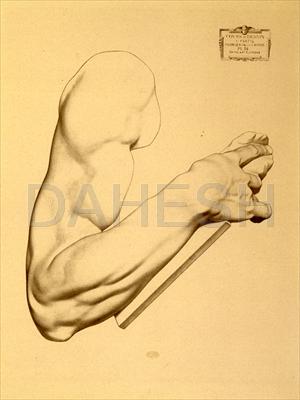Charles Bargue (French, 1826/7–1883)
The Arm of Moses by Michelangelo, ca. 1868
From the Drawing Course (Cours de Dessin). “Part I: Drawing after Casts (Modèles d’Après la Bosse),” plate I, 24. Paris: Goupil & Cie, 1868.
Lithograph on gray paper, 24 x 18 9/16 in.
Stamped upper right: COURS de DESSIN Ier PARTIE MODÈLES d’Après La Bosse Pl 24, GOUPIL & Cie EDITEURS; Foundry mark lower right: E. SCHMOLL PARIS 80 RUE DE TURELLE
2001.10

Before studying plaster casts or live models, art students usually tried to master the skill of drawing by copying two-dimensional images. They did so on their own or with teachers, with the help of manuals or drawing courses. One of the more famous drawing courses was compiled by the painter and lithographer Charles Bargue, in collaboration with the leading academician Jean-Léon Gérôme, and published by the art dealer Adolphe Goupil between 1868 and 1873. This Drawing Course (Cours de Dessin) contained 197 loose-leaved lithographs divided over three volumes, each focusing on a different area of practice.
The first volume provided examples of plaster casts, systematically studying different body parts in isolation so that the pupil may focus on each element before attempting to reproduce a full human figure. An independent, full-plate image, The Arm of Moses was meant as the culmination of the section on arms, providing the Drawing Course pupil with an example of challenging arm muscle structure to copy without the aid of an already deconstructed form. The arm in question comes from the statue of Moses (1513–16, Church of San Pietro in Vincoli, Rome) by the great Renaissance sculptor and painter Michelangelo, an artist notorious for the complex musculature of his figures.


